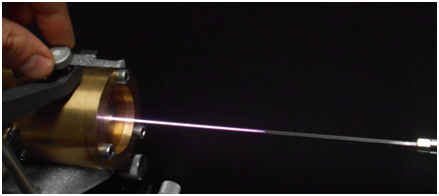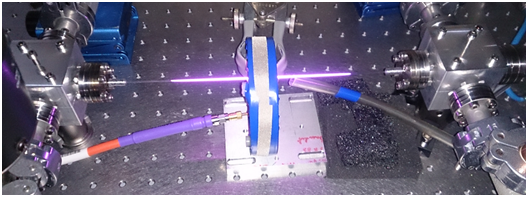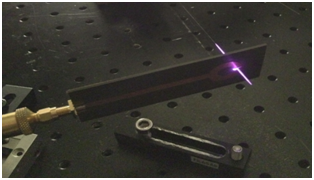Microwave micro-discharges in fibres and capillaries
Contact : Olivier LEROY
This theme was initiated by a collaboration between LPGP and XLIM in Limoges in 2009, with the aim of combining our skills in the field of plasmas and the design of microwave excitation devices (2.45 GHz) with their skills in the field of optical fibres. The aim was highly ambitious, involving the creation of micro-plasmas in hollow-core optical fibres for photonics applications. To optimise the coupling of power to the plasma, we designed, built and successfully tested an innovative excitation system using microwave 'surface waves' to create a continuous (non-pulsed) micro-plasma. It has opened up many new perspectives in the field of fibre photonics.
Building on our experimental successes, we have continued our partnership with XLIM, as part of two ANR/DGA-ASTRID projects. The first 'emergence' project, from 2011 to 2014, entitled 'UV-Factor', created a compact, flexible UV-emitting source based on the generation of a microplasma in a hollow-core fibre. From 2015 to 2018, it was continued with a 'maturation' project entitled 'Plasma-PMC'.
Other studies were undertaken on microwave microplasmas in capillary tubes (diameter < 1 mm). Micro-fluidics was probed as part of the "MicroCAP" project supported by Labex LaSIPS (2013-2014). We have shown that it is possible to vary the density of flowing neutral gas in the capillary in the plasma production region. In 2015, this device was studied for surface treatment on the inner wall of capillaries, as part of the "InnoPLAS" project supported by Labex PALM.
A collaboration with EM2C (CentraleSupélec) took place as part of the "ThermoPLAS" project supported by the Labex LASIPS (since early 2017, with funding for Fabien Coquery's thesis defended in March 2021). The aim of this project was to characterise the plasma and heat transfer in capillaries in order to optimise the production of high densities of active species (e.g. NO in an air plasma).
There are several advantages to using microwaves to generate a micro-plasma
i) the production of a plasma in a continuous regime (i.e. continuous reactivity, in contrast to other modes of excitation of micro-plasmas which are generally pulsed, such as DBDs, nanosecond discharges, RF, etc.);
ii) the absence of electrodes in contact with the flowing fluid (thus eliminating ageing and pollution problems);
iii) operation at very low microwave power levels (typically < a few tens of watts), while injecting very high power densities (~10 kW.cm-3);
iv) operation over a very wide pressure range, from 10-5 mbar to atmospheric pressure.
v) the creation of very high densities of ionised species (electrons and ions), active species and photons, and by extension the very high power density, which opens the way to many potential applications.
Thanks in particular to electromagnetic simulations, we have designed and successfully tested several types of exciter adapted to small-diameter capillaries and/or hollow optical fibres in two ways:
- miniature surfatrons, an example of which is shown in the photo below

- devices based on microstrip and/or stripline, some examples below:


